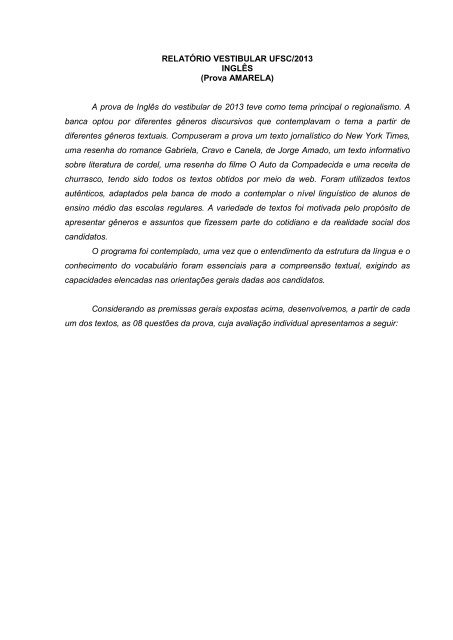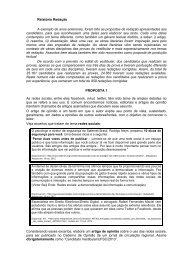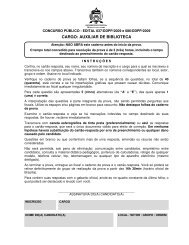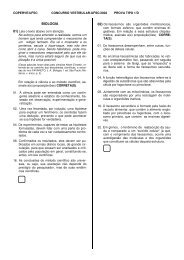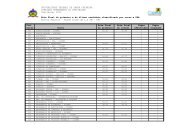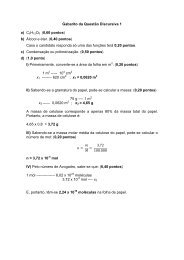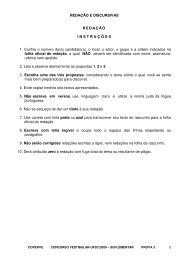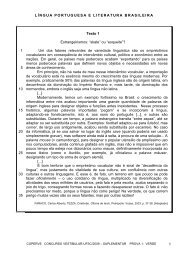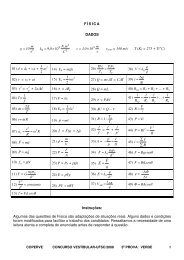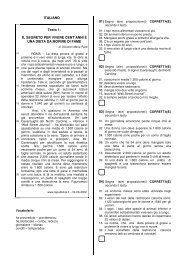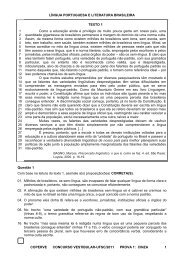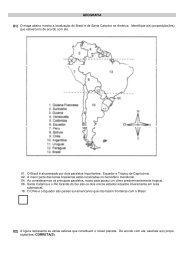Prova comentada - UFSC
Prova comentada - UFSC
Prova comentada - UFSC
You also want an ePaper? Increase the reach of your titles
YUMPU automatically turns print PDFs into web optimized ePapers that Google loves.
RELATÓRIO VESTIBULAR <strong>UFSC</strong>/2013<br />
INGLÊS<br />
(<strong>Prova</strong> AMARELA)<br />
A prova de Inglês do vestibular de 2013 teve como tema principal o regionalismo. A<br />
banca optou por diferentes gêneros discursivos que contemplavam o tema a partir de<br />
diferentes gêneros textuais. Compuseram a prova um texto jornalístico do New York Times,<br />
uma resenha do romance Gabriela, Cravo e Canela, de Jorge Amado, um texto informativo<br />
sobre literatura de cordel, uma resenha do filme O Auto da Compadecida e uma receita de<br />
churrasco, tendo sido todos os textos obtidos por meio da web. Foram utilizados textos<br />
autênticos, adaptados pela banca de modo a contemplar o nível linguístico de alunos de<br />
ensino médio das escolas regulares. A variedade de textos foi motivada pelo propósito de<br />
apresentar gêneros e assuntos que fizessem parte do cotidiano e da realidade social dos<br />
candidatos.<br />
O programa foi contemplado, uma vez que o entendimento da estrutura da língua e o<br />
conhecimento do vocabulário foram essenciais para a compreensão textual, exigindo as<br />
capacidades elencadas nas orientações gerais dadas aos candidatos.<br />
Considerando as premissas gerais expostas acima, desenvolvemos, a partir de cada<br />
um dos textos, as 08 questões da prova, cuja avaliação individual apresentamos a seguir:
Text 1<br />
The Dictionary of American Regional English<br />
01<br />
02<br />
03<br />
04<br />
05<br />
06<br />
07<br />
08<br />
09<br />
10<br />
11<br />
12<br />
13<br />
14<br />
15<br />
16<br />
17<br />
18<br />
19<br />
20<br />
21<br />
Joan Houston Hall, a lexicographer, is concerned about the use of regionalisms<br />
throughout the country. She works in one of America’s most ambitious lexicographical<br />
projects, which culminates with the publication of a dictionary by Harvard University<br />
Press, 50 years after the project was inaugurated by Frederic G. Cassidy.<br />
Mr. Cassidy, who died in 2000, did not make it to the end of the alphabet. But to<br />
scholars and language lovers the work he set in motion is an invaluable guide to the way<br />
Americans not only speak but also live. The dictionary includes nearly 60,000 terms,<br />
many of them reflecting the country’s rural and agricultural past. But among the pages<br />
and pages of names for wildflowers and farm implements, DARE, as the dictionary is<br />
commonly known, includes enough newer terms to suggest that the state of regional<br />
English isn’t quite as bad as may suggest the laments about the homogenizing forces of<br />
urbanization, mass media and the Internet.<br />
Ms. Hall recognizes that the extremes of regional speech are disappearing;<br />
however, she is pleased to find out that there are still lots of regional words. If it has<br />
become harder to find many different terms for outdated expressions, that’s partly<br />
because people today are more likely to be talking about fast food or traffic. In fact, in the<br />
age of Twitter and Facebook, linguists say, the interactions that most powerfully shape<br />
our speech are still local and face to face. In sum, American English actually has more<br />
words for the same things than ever before.<br />
Adapted from: .<br />
Accessed on August 14 th , 2012.<br />
Questão 13<br />
Select the CORRECT proposition(s).<br />
Regarding the dictionary mentioned in Text 1, it is correct to state that:<br />
01. the Dictionary of American Regional English is a result of one of America’s most ambitious<br />
lexicographical projects.<br />
02. Joan Houston Hall is the only lexicographer responsible for the dictionary published by<br />
Harvard University.<br />
04. the dictionary which is a product of a group of students from Harvard consists of almost<br />
60,000 terms.<br />
08. the Dictionary of American Regional English is also known as DARE.<br />
16. the inclusion of newer terms in the Dictionary of American Regional English suggests that<br />
the state of regional English isn’t so bad.
Questão 14<br />
Select the CORRECT proposition(s) about Text 1.<br />
01. The Dictionary of American Regional English is a scientific article about a scientific<br />
experiment.<br />
02. The text adapted from The New York Times was released originally in February 25 th , 2012.<br />
04. The text is about a dictionary whose project was started by Frederic G. Cassidy.<br />
08. The text was written by Joan Houston Hall, a lexicographer who works with dictionaries.<br />
16. The Dictionary of American Regional English is a text printed in the mass media about people<br />
who like dictionaries.<br />
Questão 15<br />
Select the proposition(s) which presents (present) CORRECT explanations for the<br />
expressions below, as they are used in Text 1.<br />
01. not only but also (line 9): adding information<br />
02. nearly (line 10): indicating distance<br />
04. more likely to (line 20): expressing probability<br />
08. in fact (line 21): emphasizing information<br />
16. in sum (line 22): providing additional ideas<br />
32. actually (line 23): reinforcing ideas<br />
Texto 01 – Este texto foi adaptado a partir de uma reportagem de 2012 do jornal New York<br />
Times e abordava um projeto lexicográfico que visava à publicação de um dicionário de<br />
termos regionais do Inglês americano. Nas questões 13 e 14, esperava-se que o candidato<br />
escolhesse as proposições de forma a demonstrar a compreensão das informações contidas<br />
no artigo jornalístico. Contrariamente à previsão da banca, a questão 13 revelou-se fácil,<br />
conforme os dados do quadro abaixo:<br />
Número de acertos: 2626 (27,47%)<br />
Grau de dificuldade previsto: difícil<br />
Grau de dificuldade obtido: fácil<br />
De modo semelhante, a banca considerou previamente a questão 14 como média e os<br />
resultados mostraram um resultado diferente, uma vez que o percentual aponta para um<br />
grau de dificuldade fácil:<br />
Número de acertos: 3922 (41,07%)<br />
Grau de dificuldade previsto: médio<br />
Grau de dificuldade obtido: fácil<br />
A questão 15, prevista como difícil, não contrariou as expectativas. As proposições exigiam<br />
do candidato um conhecimento mais específico das estruturas linguísticas, além de uma<br />
capacidade de relacioná-las às informações do texto. Acredita-se que a presença da
expressão “more likely to”, cujo uso é menos frequente, e também a presença do advérbio<br />
de modo “actually”, um falso cognato, fizeram com que as proposições 04 e 32, nas quais<br />
essas expressões apareciam, se tornassem mais difíceis.<br />
Text 2<br />
Gabriela, Clove and Cinnamon<br />
Gabriela, Clove and Cinnamon is a Brazilian modernist novel. It<br />
was written by Jorge Amado in 1958 and it is widely considered one of<br />
his finest works. The action of the novel begins in 1925 in the provincial<br />
port of Ilhéus in Brazil's northeastern state of Bahia.<br />
The book tells two separate but related tales: first, the romance<br />
between Nacib Saad and Gabriela. Second, it describes the political<br />
struggle between the old guard of Cacao growers and the forces of<br />
modernization, in the person of Mundinho Falcão. It can be read<br />
simultaneously as an unusual, charming love story, a description of the<br />
political and social forces at work in 1920s Brazil, a somewhat satirical<br />
depiction of Latin American aspirations to "modernity", and a<br />
celebration of the local culture and pleasures of Bahia.<br />
Adapted from: .<br />
.<br />
Accessed on August 17 th , 2012.<br />
Image from: http://www.amazon.com/gp/customermedia/product-gallery/<br />
0307276651/ref=cm_ciu _<br />
pdp_images_0ie=UTF8&index=0&isremote=0>.<br />
Accessed on Augus 7 th ,2012.<br />
Questão 16<br />
Select the CORRECT proposition(s).<br />
According to the review of the novel Gabriela, Clove and Cinnamon, it is<br />
01. an attractive love story and a portrayal of the political and social forces interacting in<br />
Brazil in the twentieth century.<br />
02. a typical and common love story which combines regional society customs with a<br />
satirical depiction of Latin America aspirations to "modernity".<br />
04. an account to some extent satirical of Latin American aspirations to "modernity".<br />
08. a book that is composed of two different stories which are interconnected.<br />
16. one of Jorge Amado’s best novels which takes place in the second decade of the<br />
twentieth century in Brazil.<br />
32 a book which should be read concurrently with any other Jorge Amado’s modernist<br />
novel.<br />
64. a story which combines love, enjoyment, political and social aspects focused on a<br />
provincial region in the northeast of Brazil.
Texto 02 – Este texto expressa opiniões acerca do romance regional Gabriela, Cravo e<br />
Canela, de Jorge Amado. A opinião da banca em relação à questão 16, considerada como<br />
difícil, concretizou-se nos resultados. Acredita-se que o número elevado de proposições e a<br />
extensão delas tenham contribuído para o baixo índice de acertos. Importa ainda registrar<br />
que, sobre o baixo índice de acertos na proposição 04, a banca infere que ele tenha sido<br />
decorrente da falta de conhecimento dos candidatos acerca da correspondência entre as<br />
expressões “a somewhat satirical depiction”, utilizada no texto, e “an account to some extent<br />
satirical”, utilizada na proposição.<br />
Número de acertos: 202 (2,11%)<br />
Grau de dificuldade previsto: difícil<br />
Grau de dificuldade obtido: difícil<br />
Text 3<br />
Introducing Cordel<br />
Image from: .<br />
Accessed on August 17 th , 2012.<br />
Brazil's "literatura de cordel" is a kind of folk-popular poetry ______ involves both the<br />
oral and written traditions and is very popular in northeastern Brazil. After a hiatus of<br />
______ years when its production fell ______ because of economic and social change<br />
in Brazil, it is ______ a revival due primarily to the personal computer and printer which<br />
allow poets to ______ the high cost of typographies and printing shops. In addition,<br />
there is a large ______ of "cordel" type poetry on the internet.<br />
Adapted from: .<br />
Accessed on August 17 th , 2012.<br />
Questão 17<br />
Choose the CORRECT proposition(s) to complete the text above.<br />
01. what – many – chiefly – transforming – refuse – occurrence<br />
02. which – some – significantly – experiencing – avoid – presence<br />
04. there – various – largely – renovating – decline – attendance<br />
08. who – few – extensively – increasing – change – existence<br />
16. that – several – considerably – undergoing – escape – incidence
Texto 03 – Este texto, que apresenta uma breve descrição da literatura de cordel, foi<br />
utilizado na prova para compor a questão 17, com o objetivo de avaliar a capacidade dos<br />
candidatos de selecionar as proposições cujas palavras se adequassem aos contextos<br />
linguísticos específicos. Desse modo, além do conhecimento de vocabulário, os candidatos<br />
precisavam compreender o sentido global do texto. A banca previu um grau de dificuldade<br />
médio, que, no entanto, revelou-se como fácil.<br />
Número de acertos: 2585 (27,07%)<br />
Grau de dificuldade previsto: médio<br />
Grau de dificuldade obtido: fácil<br />
Text 4<br />
O Auto da Compadecida<br />
O Auto da Compadecida is a 2000 Brazilian comedy film, directed by Guel Arraes, with<br />
a screenplay by Arraes and Adriana Falcão. It is based on the 1955 play of almost the same<br />
name by Ariano Suassuna.<br />
The plot concerns the adventures of João Grilo (Matheus Natchergaele) and Chicó<br />
(Selton Mello), the most cowardly of men. The lively João Grilo and the tricky Chicó are poor<br />
guys who cheat a bunch of people in a small northeast Brazilian town. But when they die, they<br />
have to be judged by Christ, the Devil and the Virgin Mary, before they are admitted to<br />
paradise.<br />
The film was a critical and commercial success in Brazil and in some South American<br />
countries like Chile and Venezuela. It was not as well-received in English-speaking countries.<br />
Adapted from: .<br />
. Accessed on August 17 th , 2012.<br />
Questão 18<br />
Select the proposition(s) which contains (contain) CORRECT answers for the following<br />
questions, according to the text above.<br />
01. Do the film and the play have the same name<br />
Yes, they do.<br />
02. Which came first, the movie or the play<br />
The play did.<br />
04. Were João Grilo and Chicó brave guys<br />
No, they weren’t.<br />
08. Where does the action take place<br />
In the northeast of Brazil.<br />
16. What happens at the end of the film<br />
João Grilo and Chicó go to hell.<br />
32. Was the film a success everywhere<br />
Yes, it was.
Texto 04 – O texto O auto da compadecida, uma resenha do filme lançado no ano 2000, foi<br />
utilizado para compor a questão 18, na qual se esperava que os candidatos tivessem a<br />
compreensão necessária para reconhecer as respostas corretas às perguntas formuladas<br />
nas proposições, relacionando-as ao conteúdo do texto. Esta questão foi prevista como fácil<br />
e o resultado correspondeu à previsão.<br />
Número de acertos: 3156 (32,99%)<br />
Grau de dificuldade previsto: fácil<br />
Grau de dificuldade obtido: fácil<br />
Text 5<br />
Churrasco: a typical food in the south of Brazil<br />
Brazilian food is varied and interesting. As it happens with every country, the cuisine of Brazil is<br />
strongly related to the history and culture of the country and varies from one region to another,<br />
sometimes in such a way that visitors might feel like they are in different countries. One of the most<br />
common foods in the southern region of Brazil is churrasco. A recipe of this popular food follows<br />
below:<br />
Recipe of Churrasco Gaúcho<br />
Ingredients:<br />
fine quality cuts of beef, lamb, veal, ribs, etc.<br />
salt<br />
mashed cloves of garlic<br />
water<br />
Preparation:<br />
Set the fire and be sure the coals are bright before putting on the meat. Assemble meat cuts on<br />
metallic skewers and set on the grill. Turn skewers frequently. When the meat begins to brown, make<br />
a salty liquid dissolving the salt in the water with the garlic and baste the meat with it.<br />
Hints:<br />
Cuts with more fat are the best for charcoal grilling.<br />
It takes about 1 hour above the fire.<br />
Serving:<br />
Cut slices from outside and serve. Keep meat warm on the grill while not serving. Always baste the<br />
meat waiting on the grill with the salty liquid to keep it juicy and fresh.<br />
Adapted from: .<br />
.<br />
Accessed on August 22 nd , 2012.
Questão 19<br />
Consider the following situation: Peter, who is visiting the south of Brazil, prepared a<br />
churrasco gaúcho as described below. Did he follow the recipe in Text 5<br />
Select the CORRECT proposition(s), according to Text 5.<br />
01. He set the fire and immediately put the meat over it.<br />
02. He turned the skewers only when the meat was almost ready.<br />
04. He mixed the water, the salt and the garlic together.<br />
08. He took out all the fat from the meat.<br />
16. He returned the meat to the grill after cutting some slices.<br />
32. He covered the meat kept on the grill with the salty liquid.<br />
Questão 20<br />
Select the CORRECT proposition(s) to complete the following sentence.<br />
The text “Churrasco Gaúcho” gives information about:<br />
01. the kinds of meat that can be used.<br />
02. the price of the ingredients.<br />
04. the quantities for each person.<br />
08. the time the meat should stay on the grill.<br />
16. the right size of the cuts.<br />
32. the way to serve the churrasco gaúcho.<br />
Texto 05 – As duas últimas questões da prova foram elaboradas a partir deste texto que<br />
comentava a variedade da culinária brasileira e sua relação com a história e com a cultura<br />
do país. Após uma breve introdução, o texto apresentava uma receita regional, o churrasco<br />
gaúcho. Para resolver com sucesso a questão 19, os vestibulandos deveriam demonstrar<br />
boa compreensão das instruções da receita. A expectativa em relação a esta questão era de<br />
que apresentaria um grau médio de dificuldade. No entanto, o resultado obtido superou essa<br />
expectativa, pois a questão mostrou-se fácil. A análise dos resultados mostra que, ainda<br />
assim, muitos candidatos não chegaram ao resultado correto por não terem reconhecido<br />
como válida a proposição 32. Para tanto, era importante saber o significado da palavra<br />
“baste” (regar, untar), vocábulo usado no texto mas pouco encontrado em outros contextos.<br />
Número de acertos: 3580 (37,49%)<br />
Grau de dificuldade previsto: médio<br />
Grau de dificuldade obtido: fácil
A questão 20 testava a compreensão geral do texto, mas exigia também a compreensão de<br />
um léxico específico, relacionado a diferentes tipos de carnes e a maneiras de preparar um<br />
churrasco. Confirmando a previsão feita pela banca, a questão apresentou resultado que a<br />
classifica como fácil. Das três proposições corretas, observamos que a 01 apresentou maior<br />
dificuldade, possivelmente pelo desconhecimento por parte de muitos vestibulandos das<br />
palavras “lamb, veal, ribs”, presentes no texto, que representam os tipos de carne (“meat”),<br />
mencionados na proposição 01.<br />
Número de acertos: 3560 (37,23%)<br />
Grau de dificuldade previsto: fácil<br />
Grau de dificuldade obtido: fácil<br />
A banca considera que a prova atingiu os objetivos esperados, uma vez que um número<br />
considerável de candidatos entendeu a proposta e respondeu conforme o esperado. Foram<br />
utilizados textos, gêneros, estruturas e vocabulário adequados ao programa e ao conteúdo<br />
estipulado para o ensino médio, de acordo com orientações curriculares nacionais e também<br />
de acordo com o programa do vestibular. O foco em questões que objetivavam a<br />
competência como seleção de informações e negociação de significados a partir dos textos<br />
permitiu que os candidatos pudessem lidar com a linguagem como produto cultural e social<br />
que se faz presente em suas práticas cotidianas.


